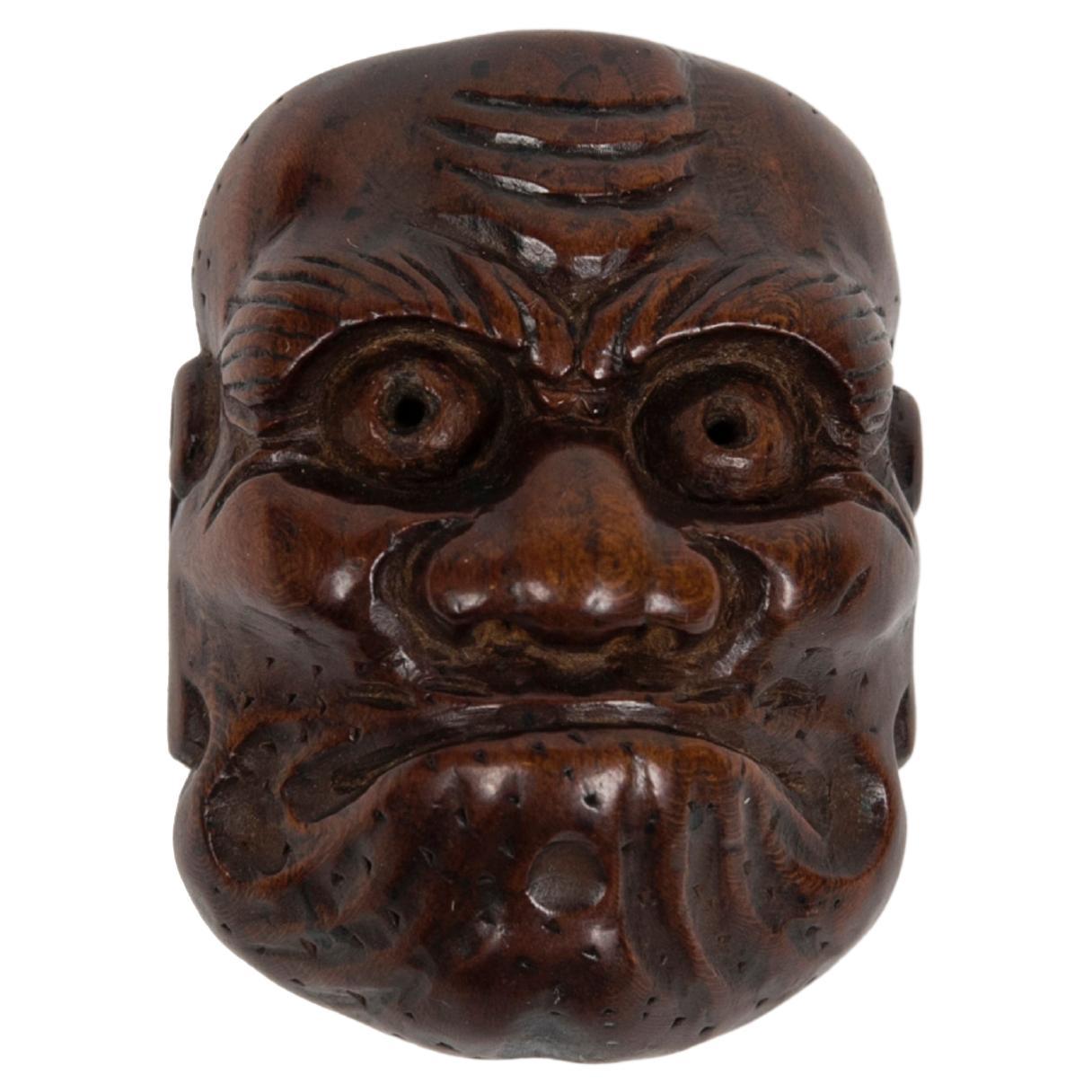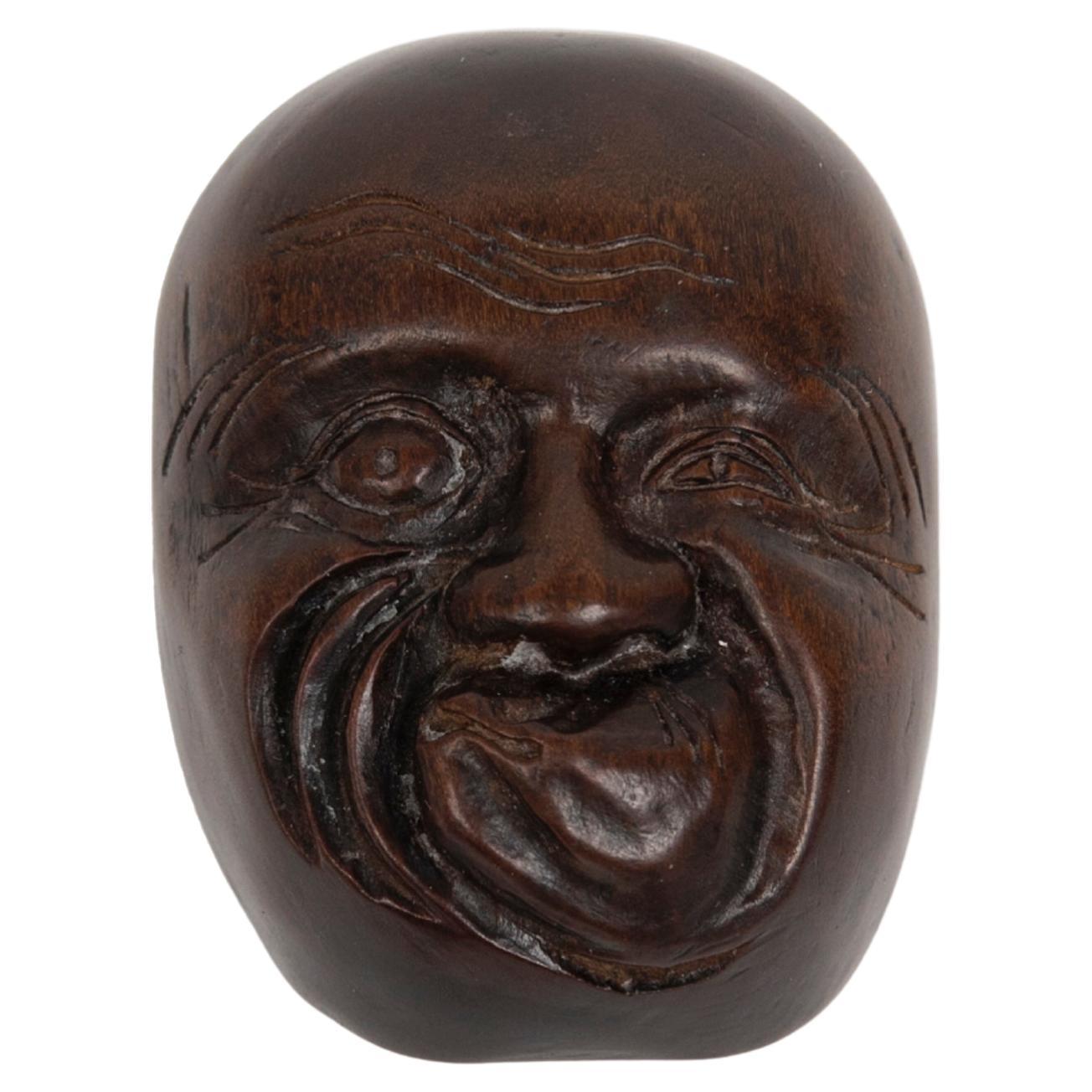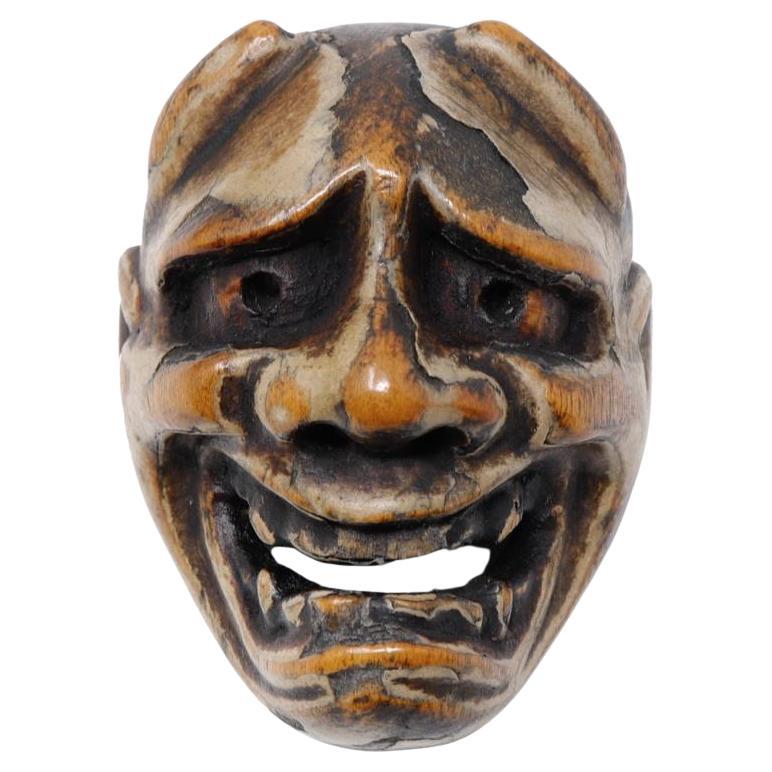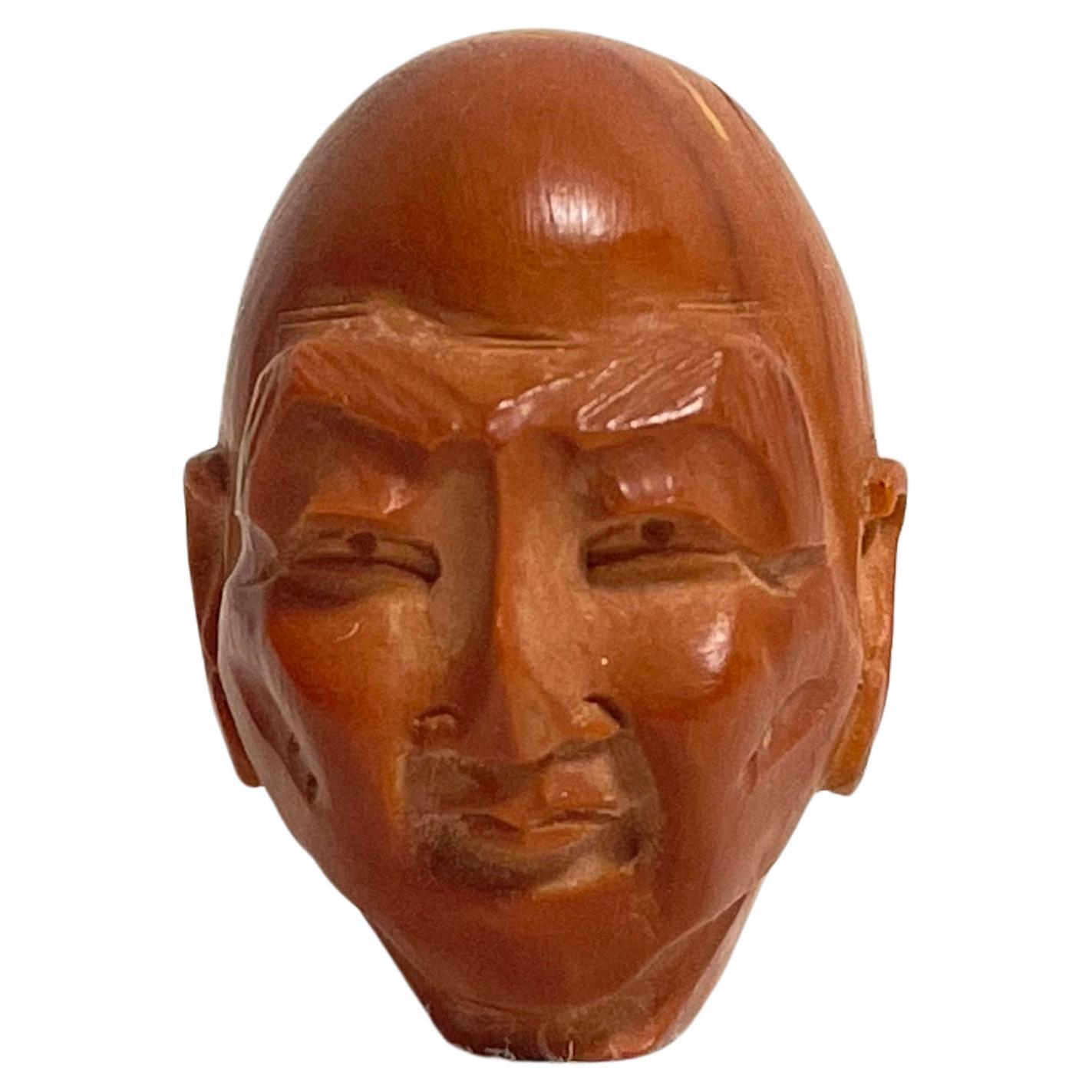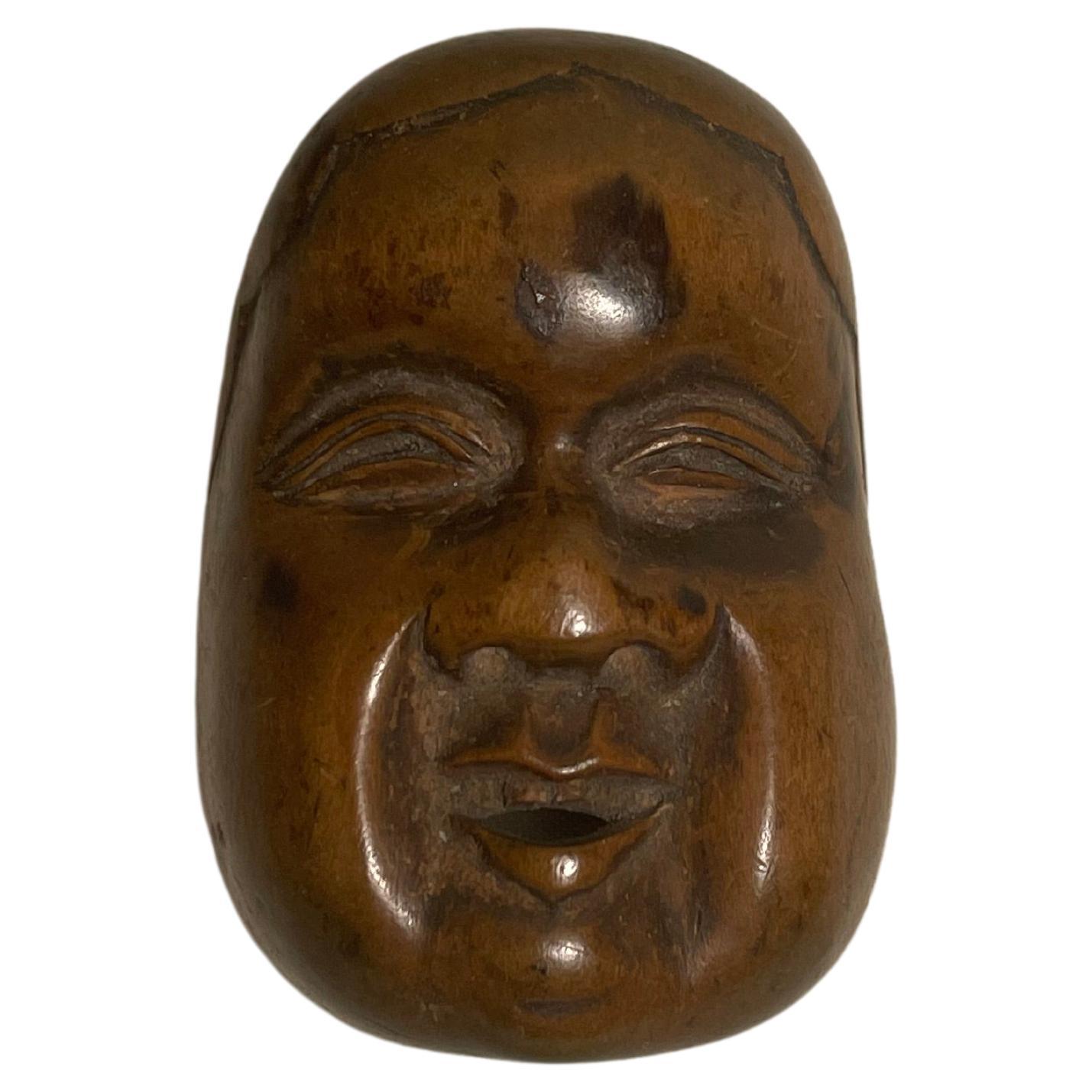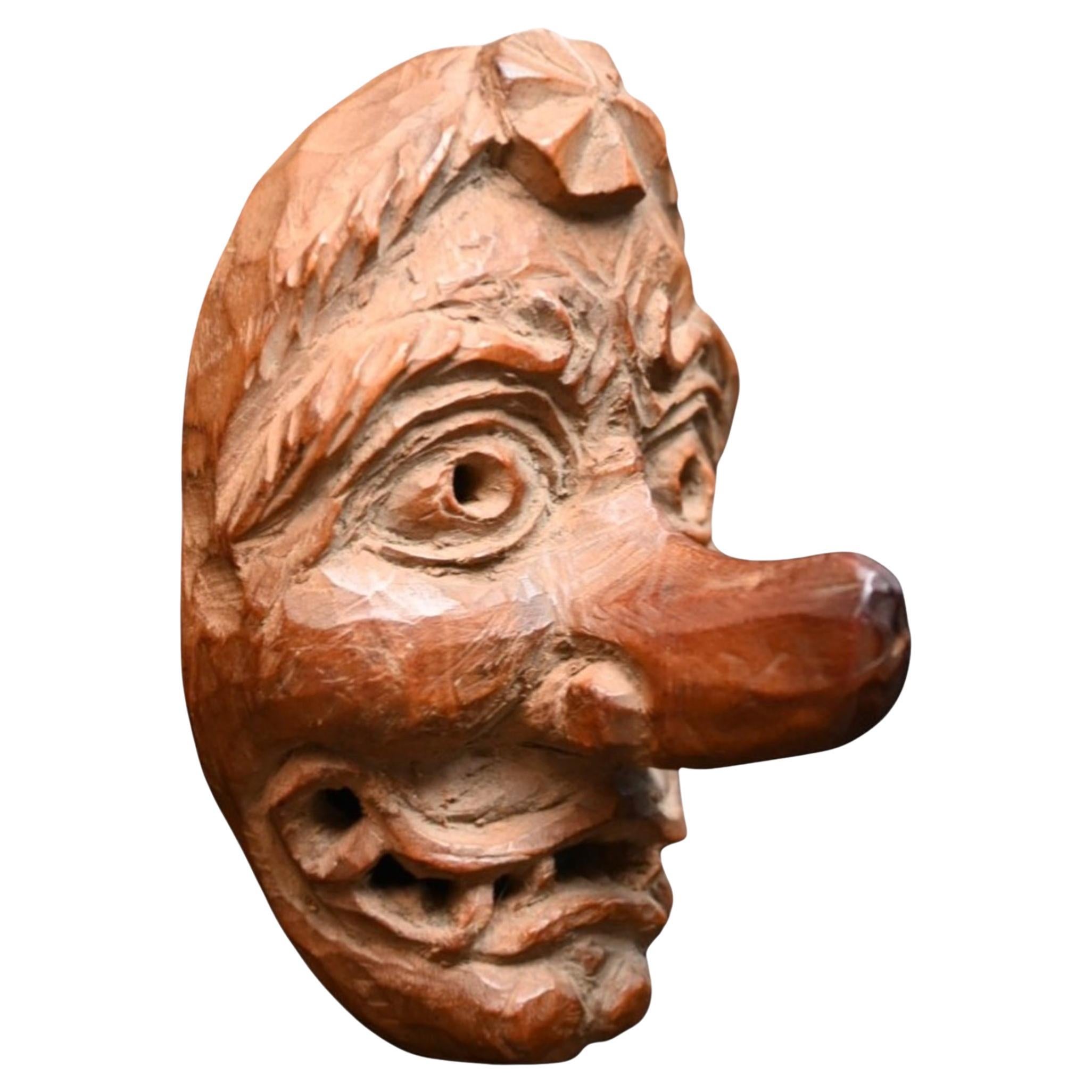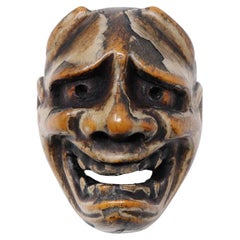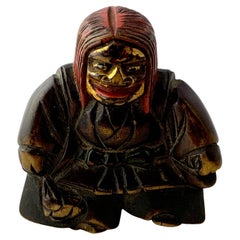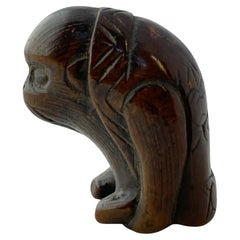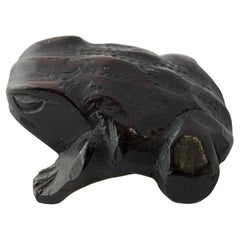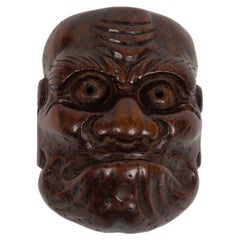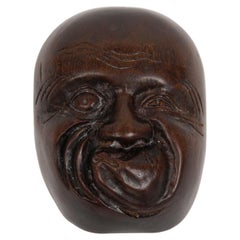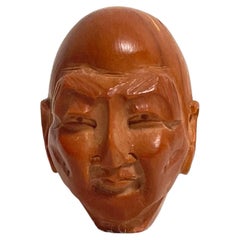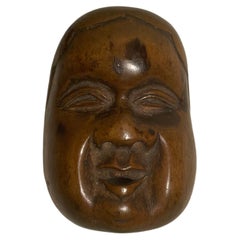Items Similar to Japanese Netsuke of Hyottoko, Depicted through a Mask in Noh Play as an Idiot
Want more images or videos?
Request additional images or videos from the seller
1 of 7
Japanese Netsuke of Hyottoko, Depicted through a Mask in Noh Play as an Idiot
$750
£566
€647.99
CA$1,057.75
A$1,161.28
CHF 605.84
MX$14,053.06
NOK 7,593.27
SEK 7,154.85
DKK 4,837.07
About the Item
Playfully carved out of boxwood, this Meiji period hyottoko noh mask netsuke features a figure of a crouching man on the reverse. In Iwate Prefecture, there is a myth about the origin of Hyottoko. In the story, there was a boy with a bizarre face who could create gold out of his belly button, so when someone died in a house, you would put the mask of this boy at the top of the fireplace to bring good fortune to the house. The name of the boy was Hyoutokusu (ヒョウトクス). This is considered one of the possible names that lend plausibility to the origin of Hyottoko.
The word netsuke is formed using the symbol ne (根) meaning “root" and tsuke (付) meaning “attach.” The first netsuke were created in late sixteenth-century Japan as simple button fasteners for pouches and other containers that were hung on the sash (obi 帯) of a kimono. As time progressed, the carving of these small figures became increasingly intricate as netsuke transformed from purely functional objects into fashionable indicators of status. Netsuke commonly depict imagery from nature, myth, and Japanese history.
Measures .75" x 1.25" x 1.25" and weighs .7oz (20g).
- Dimensions:Height: 1.25 in (3.18 cm)Width: 1.25 in (3.18 cm)Depth: 0.75 in (1.91 cm)
- Style:Meiji (Of the Period)
- Materials and Techniques:
- Place of Origin:
- Period:
- Date of Manufacture:1880
- Condition:Wear consistent with age and use.
- Seller Location:Point Richmond, CA
- Reference Number:Seller: GU2581stDibs: LU1778242865002
About the Seller
5.0
Platinum Seller
Premium sellers with a 4.7+ rating and 24-hour response times
Established in 1999
1stDibs seller since 2015
701 sales on 1stDibs
Typical response time: 2 hours
- ShippingRetrieving quote...Shipping from: Point Richmond, CA
- Return Policy
Authenticity Guarantee
In the unlikely event there’s an issue with an item’s authenticity, contact us within 1 year for a full refund. DetailsMoney-Back Guarantee
If your item is not as described, is damaged in transit, or does not arrive, contact us within 7 days for a full refund. Details24-Hour Cancellation
You have a 24-hour grace period in which to reconsider your purchase, with no questions asked.Vetted Professional Sellers
Our world-class sellers must adhere to strict standards for service and quality, maintaining the integrity of our listings.Price-Match Guarantee
If you find that a seller listed the same item for a lower price elsewhere, we’ll match it.Trusted Global Delivery
Our best-in-class carrier network provides specialized shipping options worldwide, including custom delivery.More From This Seller
View AllAntique Japanese Wood Miniature Mask Netsuke
Located in Point Richmond, CA
Antique Japanese Wood Miniature Mask Netsuke, an unsigned work depicting Hannya, the female horned demon popular in Noh performance plays, a solid hardwood piece carved in high relie...
Category
Antique 19th Century Japanese Edo Sculptures and Carvings
Materials
Wood
Netsuke of an Oni, a Demon in Japanese Folklore, Wood, Early 20th Century
Located in Point Richmond, CA
A Meiji period netsuke depicting a formidable figure of an oni (demon) with a golden face and red hair. Onis were thought to ward off evil spirits and were often depicted on netsuke ...
Category
Early 20th Century Japanese Meiji Figurative Sculptures
Materials
Boxwood
Mid-Century Japanese Carved Wood Netsuke of a Sitting Monkey
Located in Point Richmond, CA
Hand-carved mid-century netsuke depicting a contemplative monkey in a sitting position. Monkeys represent multiple things in Japanese culture and folklore among them being: mediators...
Category
Mid-20th Century Japanese Mid-Century Modern Animal Sculptures
Materials
Wood
Japanese Carved Wood Netsuke of a Frog, Taisho Period
Located in Point Richmond, CA
Hand carved boxwood frog netsuke dating from the Meiji period. The frog (kaeru) is associated with luck and wealth in Japanese culture. Kaeru in is a homophone meaning both "frog" an...
Category
Early 20th Century Japanese Taisho Animal Sculptures
Materials
Boxwood
Large Wood Carved Otafuku, Goddess of Mirth, Japanese, Early 20th Century
Located in Point Richmond, CA
Large wood carved Otafuku , Goddess of Mirth, Japanese, 20th Century.
Sometimes known as Okame, a beloved and popular symbol in Japanese culture. With plump cheeks and joyful smile...
Category
Early 20th Century Japanese Other Sculptures and Carvings
Materials
Wood
Antique Japanese Mingei Yokogi
Located in Point Richmond, CA
Antique Japanese Yokogi, a fish shaped fulcrum for the pot hook assembly over the hearth, a naively carved Tai (Sea Bream) with large head pierced for the hooked pole and the large tail pointed upward with a metal loop for the cord attachment, incised carving for facial details and scales, encrusted patina from use. Wood storage box made of hinoki.
Excellent condition.
5-7/8 in. high x 14-3/4 in. long x 4 in. wide.
Weight: 4 lbs. 4 oz.
Late Edo, Circa 1800.
Published in a Japanese newspaper in 1964 (article and translation available).
Provenance:
with Kingo Kondo, Kyoto 1964
Ken Domon...
Category
Antique Early 1800s Japanese Edo Sculptures and Carvings
Materials
Wood
You May Also Like
Netsuke in the form of a No mask representing the character of Obeshimi
Located in PARIS, FR
Wooden netsuke depicting the Obeshimi mask in Noh theater.
Obeshimi is a demon characterized by thick eyebrows, eyes that seem to protrude from the face and a closed mouth.
Signed ...
Category
Antique Late 19th Century Japanese Meiji Sculptures and Carvings
Materials
Boxwood
Netsuke in the form of a No mask representing the character of Hyottoko
Located in PARIS, FR
Boxwood netsuke representing the mask of Hyottoko in Noh theatre.
Hyottoko is a legendary comic character, considered to be a fire god in certain regions of north-east Japan. The sha...
Category
Antique Late 19th Century Japanese Edo Sculptures and Carvings
Materials
Boxwood
Japanese Wooden Small Netsuke 'A Head' 1940s Showa era
Located in Paris, FR
This is an antique wooden netsuke made in Japan around Showa period 1940s.
Netsuke is a miniature sculpture, originating in 17th century Japan....
Category
Vintage 1940s Japanese Showa Animal Sculptures
Materials
Wood
Japanese Antique Wooden Netsuke 'Onnamen' 1950s
Located in Paris, FR
This is an antique netsuke made in Japan around Showa period 1950s.
Dimensions: 4.5 x 3.5 x H2.2 cm
Sculpture: Onnamen
Era: 1950s (Showa)
Netsuke is a miniature sculpture, origin...
Category
Late 20th Century Japanese Showa Sculptures and Carvings
Materials
Wood
Japanese Netsuke – Grotesque Mask, Edo To Early Meiji Period (circa 1820–1880)
Located in Bilzen, BE
"Japanese Netsuke – Grotesque Mask, Edo To Early Meiji Period (circa 1820–1880)"
A finely carved and expressive wooden mask-style netsuke, depicting a grotesque theatrical or folklor...
Category
Antique 19th Century Japanese Meiji Sculptures and Carvings
Materials
Wood
Carved Boxwood and Lacquer Netsuke of a Noh Dancer, Meiji Period, Japan
Located in Austin, TX
A fine lacquer decorated carved boxwood netsuke of a Noh dancer in a Hannya role, unsigned, Meiji period, late 19th century, Japan.
The boxwood netsuke finely carved as a kneeling Noh dancer dressed in striking geometric patterned robes. The actor holds an opened war fan behind their back in one hand, a Shinto wand slung over the shoulder in the other.
The war fan, tessen, decorated in red lacquer with a golden rising sun at the center. Tessen were sturdy fans used by samurai as protective devices, and sometimes as weapons.
The wand, called an onusa, is a traditional Shinto ritual implement comprised of folded paper streamers, shide, attached to a wooden wand, often used in purification rituals. Here, the shide are crafted from silver maki-e, with the handle of the natural boxwood.
The actor wears a fierce and unearthly hannya mask...
Category
Antique 1890s Japanese Meiji Sculptures and Carvings
Materials
Boxwood, Lacquer
